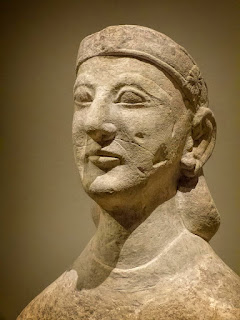Less stylized Amarna portraiture
During Akhenaten's reign, royal portraiture underwent dramatic change, often depicting the pharaoh in an androgynous and highly stylized manner. Artists showed subjects with elongation and narrowing of the neck and head, sloping of the forehead and nose, a prominent chin, large ears and lips as well as lowered eyelids. Each figure was also illustrated with a more elongated body than previous representations. In the new human form, the subject had more fat in the stomach, thigh, and breast region, while the torso, arm, and legs were thin and long like the rest of the body. The skin color of both male and female is generally dark brown (contrasted with the usual dark brown or red for males and light brown or white for females). Figures in this style are shown with both a left and a right foot, contrasting the traditional style of being shown with either two left or two right feet and fingers and toes are depicted as long and slender and are carefully detailed to show nails.
The Brooklyn Museum points out that the unusual, elongated skull shape often used in portrayal of the royal family "may be a slightly exaggerated treatment of a hereditary trait of the Amarna royal family given that "the mummy of Tutankhamun, presumed to be related to Akhenaten, has a similarly shaped skull." Some scholars, though, suggest that the presentation of the human body as imperfect during the Amarna period is in deference to Aten while others interpret this unprecedented stylistic break from Egyptian tradition to be a reflection of the Amarna Royals' attempts to wrest political power from the traditional priesthood and bureaucratic authorities.
However, some less stylized portrait sculpture has survived from this period including these portrait heads of Akhenaten and Nefertiti that I photographed at the Neues Museum in Berlin back in 2016. Although Akhenaten's portrait does feature the lowered lids, the skull shape and more normal anatomical appearance of the facial structures would seem to discount the presence of some of the more severe genetic disorders that have been proposed.
After Akhenaten's death, the new capital was abandoned, and traces of his monuments elsewhere defaced. Remains of Amarna art are therefore concentrated in Amarna itself, but some remains have been found at Karnak, where large reliefs in the style were dismantled, and the blocks turned round to face inwards when a later building was constructed using them. These were only rediscovered in recent decades.
Image: Portrait heads of the royal couple Akhenaten and Nefertiti, 18th Dynasty, Egypt, 1340 BCE that I photographed at the Neues Museum in Berlin, Germany in 2016.

























